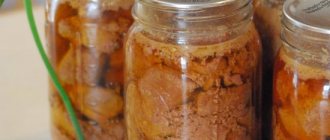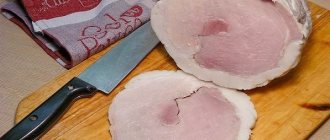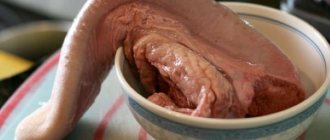The stew, without a doubt, has lost its former strategic importance, which it had a couple of decades ago. However, for some categories of humanity it remains as important as ever. These primarily include hunters, tourists, fishermen, that is, those who spend a long time in nature, in “wild” conditions. And if a traveler does not want to eat only porridge for several days, he will have to take stewed meat with him.
Without a doubt, you can get by with a store-bought one. But usually all sorts of trimmings, tripe and low-grade meat are allowed into it. And the degree of its freshness is often questionable. So if a person does not want to suffer with his stomach, he will have to learn how to cook stew at home in order to be completely confident in the products that he takes to places far from civilization.
What kind of meat is good?
Basically, any: beef, chicken, pork, rabbit or lamb. You can also mix several types. The main condition is that it must be fresh. Chilled will also work, but under no circumstances frozen. You buy fillet in large pieces or already chopped (for example, for goulash). You can roll a bird straight with the bones, but for a rabbit, only pieces cut from the legs are suitable for stewing. Please note that most types of meat (except pork) are quite lean, and stew necessarily requires fat, so you will have to buy additional lard. From pork, from which the fattest pieces are taken, before preparing the stew at home, the fat is cut off even before cooking.
Selection and preparation of dishes
The weakest “point” of stewed meat is its storage. Therefore, it is important to properly sterilize the containers in which it will be rolled. This can be done in any way - boiling followed by drying or calcination in the oven. It is necessary to sterilize not only the jars, but also the lids, so it is better to take the latter metal ones (or those that are rolled by a machine, or with a twist). To prevent them from rusting during storage, they are coated with fat on the outside. Heat-resistant plastic ones are also suitable, those that close hermetically - they are also boiled or calcined.
Sometimes milk cartons, which are lined with foil on the inside, are used to package the stew. But this method presupposes fairly rapid use, since it is impossible to achieve special sterility from them, and you cannot seal them hermetically. In some cases, the stew is placed in small aluminum cans, but the complaints against them are the same. For long-term storage, still choose glass jars, since preparing stew at home, wasting food, time, and then losing the result of your labor is very disappointing.
The easiest way
The most common and simple recipe for stew at home is as follows. Take fresh meat, salt, lard (in the ratio of 1 kg - 1 teaspoon - 200 g), bay leaf and peppercorns. If you have pork, lard is excluded. The meat is coarsely chopped, salted, and spices are added (if desired). Bay leaves and pepper are placed in sterile jars at the bottom, and meat on top, but you need to make sure that fatty slices are interspersed with lean ones. Lard (or pork fat) is melted and containers are filled with it. The baking sheet is generously sprinkled with coarse salt, the filled dish is placed on it, and the sheet is placed in an unheated oven. After which it is heated to 200 degrees, and the jars stand in it for about three hours, and then they are rolled up with sterile lids.
If you have beef stew, remember that such meat decreases in volume during cooking, so as it sags, you will have to add it from a jar specially designated for this.
Fragrant rabbit
If you are on a diet and care about the healthy nutrition of your household, it is better to make homemade rabbit stew. The product is rich in choline, which regulates cholesterol levels in the blood. Rabbit meat is also valuable for its high sulfur content, which is indispensable for bones and tissues.
With soy sauce
Peculiarities. Rabbit meat is tender, flavorful meat. To prepare stew from it, you can use a slow cooker. The meat will steam well in it and will be stored for several months. The quantity of products is designed for two 0.5 liter jars.
You will need:
- large rabbit carcass;
- four bay leaves;
- five peas of allspice;
- 30 ml soy sauce;
- salt at your discretion.
Preparation
- Cut the carcass and separate the meat from the bones.
- Place the rabbit and all the flavorings into the multicooker bowl.
- Cook for four hours in the “Stew” mode. It is advisable to open the lid every hour and stir the dish.
- Transfer the finished stew into sterile jars and seal.
The stew should be stored away from light sources. If you don't have a perfectly dark place in your home, wrap each jar in an opaque cloth or newspaper.
With lard
Peculiarities. The homemade rabbit stew recipe can be supplemented with lard. Fat will add juiciness and nutrition to the dish. The meat is rolled into cans already prepared, so you can fully control the degree of its readiness, as well as the balance of spices.
You will need:
- 800 g meat;
- 150 g lard;
- salt and spices at your discretion.
Preparation
- Cut the meat into pieces 2-3 cm thick, sprinkle with salt, and place on a tray in one layer. Leave for eight hours in the refrigerator.
- Melt the lard.
- Squeeze the meat slightly to get rid of excess juice and combine with fat.
- Add your favorite spices and fry until done.
- Transfer the rabbit meat and fat into a sterile container and seal.
To avoid spoilage of the stew and the development of pathogenic bacteria in the jar, it must be kept cold at a temperature no higher than 15°C. The maximum shelf life is six months.
The basis is stewing
The main ingredients and their quantities are the same. However, the chopped meat is not placed in jars, but placed salted in a dry pan. Water is not added! The vessel is placed on the lowest heat for four hours (if there is a lot of meat, then for all six). Juice will be released from the meat, in which it is stewed. To prevent it from sticking to the bottom, you must periodically stir the contents of the container. After two or three hours, add finely chopped half of the lard (it is required for beef, lamb, poultry or rabbit stew), which will slowly melt. At the very end, spices are added - at least laurel and peppercorns. Not a single recipe for stew at home includes onions and garlic - they quickly make the meat unusable. When hot, the product is placed in sterilized jars, the second half of the lard is melted, which is poured into the cooled stew. The containers are closed and stored in the cellar.
Beef stew: step-by-step recipe
- Cut the beef lard into small pieces and place it in a deep roasting pan or cauldron.
- Add vegetable oil to the lard, preferably odorless.
- Fry the beef lard until it turns into cracklings so that the fat is completely rendered.
- Wash the beef, dry it from water and cut into small pieces. Place the meat in the melted fat and fry on all sides. During frying, the meat should be stirred constantly so that it does not burn.
- When the meat is lightly fried, add salt and pepper.
- Pour hot water into the roasting pan with meat, close the lid, let it boil and reduce the heat. Simmer the meat for three hours, do not add heat.
- 30 minutes before the end of stewing, add the bay leaf and turn up the heat a little so that the excess liquid evaporates faster.
- We take sterile jars and transfer the meat from the fryer into them. Leave a little space on top, not filling the jars completely. We roll up the stew with lids that have been sterilized in advance.
As you noticed, cooking beef stew at home is not that difficult. But at any time you can open a jar of delicious, aromatic, homemade beef stew. And prepare any dishes from it: soup, potatoes or navy pasta.
Bon appetit.
Chops in a can
A very unique way to cook stew at home. For a kilo of meat, take 50 g of lard, 6 bay leaves, 2 small spoons of salt and 1 black pepper, this time ground. The meat is beaten into large pieces on both sides, two-thirds of the laurel is placed at the bottom of the container where the workpiece will be stored, and salted and peppered “chops” (as dense as possible) are placed on it. The vessel must be chosen high. The lard is finely chopped and laid out on top, with the rest of the bay leaf on top. The jars are placed in a cold oven (at the very bottom), which will gradually heat up to 180 degrees. The necks of the vessels should be tightly wrapped in foil. After three hours, the containers are taken out, the foil is removed and replaced with tight lids. This recipe produces the most delicious beef stew.
Fish preparation
If you don't trust store-bought canned goods, try making fish stew at home. It will turn out fragrant and tender, and most importantly - healthy. The bones will steam well and become soft. You just need to choose high-quality fresh raw materials. Oily river fish is more suitable for home canning. It could be silver carp, carp, crucian carp or catfish. The set of ingredients for a half-liter jar is as follows:
- 1 kg of fish without head, giblets, fins and scales;
- 6 g salt;
- three peas of black pepper;
- laurel leaf;
- 15 ml sunflower oil.
In the oven
- Cut the fish into portions, season with salt and leave for an hour and a half.
- Place spices in sterile jars and fish on top.
- Place the jar on a baking sheet filled with water. Cover the neck with foil folded in several layers.
- Place the dough in the oven and heat to 150°C.
- When the stew begins to boil, reduce the temperature to 100°C and simmer for five hours.
- Remove the foil, pour heated oil into the jar and heat for another half hour at 130°C.
- Roll up the boiled lids.
Before placing in a jar, the fish can be lightly fried. This will give it a golden crust and a more expressive aroma.
In a pressure cooker
- Place salt and spices in a jar and fish on top.
- Cover the container with a lid and place in the pressure cooker. Pour water into the device so that it reaches the middle of the jar.
- Turn on the burner and wait until it boils.
- When the water is bubbling well, reduce the heat and seal the pressure cooker tightly.
- After three hours, roll up the canned food.
Cooking with pork
Note that most housewives prefer this meat. This is easy to explain: homemade pork stew cooks faster, is softer and does not require additional lard. However, not everyone likes the greasy taste. We offer a way to disguise it and make the meat more piquant. For 800 g of meat, take 100 g of sour prunes, a large onion, bay leaf, pepper and a little lard. Fry the chopped pork and chopped onion in lard - not too much, just until lightly browned. Then add a couple of tablespoons of water and add prunes. Everything is stewed together for about ten minutes, after which it is put into jars and covered with spices.
Since the stew is packaged hot, a spoon must be placed in glass containers in advance, otherwise they may burst. The resulting meat juice is distributed evenly, and the jars are placed open in the oven on a sheet covered with salt. First, the cabinet is heated to 110 degrees, and the stew is kept in it for 40 minutes. Then the temperature rises to 180, and simmering lasts about 4 hours. The finished meat is hermetically sealed, and the jar is turned upside down until it cools. This preparation of stew is a little longer than the previously described process, but the taste of the final product is subtle and delicate.
I bought homemade stew for 3 thousand, I’m showing you what’s inside
Do you still buy stew at the store? It's a waste of money, I tell you. The meat there is not real, or just fat. It’s better to buy homemade stew, even if it’s expensive. Better yet, do it yourself. It's a hassle, but believe me, it's worth it. I bought homemade stew from a friend for 3 thousand, the can flew away in an instant. In this article I will show you what is inside such a jar.
This is not an advertisement and I will not leave you my friend’s contact information, especially since she does not sell stew throughout the country. Surely you have similar craftsmen in your city, or you simply want to make this product yourself.
This can of homemade stew costs 300 rubles. Yes, it's expensive. In a store, for a stew that is good by store standards, you need to pay only 130-140 rubles, but here it turns out to be 2 times more expensive. But what do we have?
And we have excellent natural meat in large pieces, a tasty juicy product that you just want to eat with bread. I filled the jar overnight and couldn’t resist.
Stew can't be cheap! After all, the preparation should use meat that shrinks in size during cooking. As with smoked sausage, the situation is the same. Therefore, those who buy stewed meat for 70-80 rubles have toilet paper or chemicals in general. Stop stuffing yourself with this! Buy the real product or just a piece of meat and do it yourself. Believe me, the difference is noticeable. And this will have a positive effect not only on taste buds, but also on health.
- Berghoff cookware with discounts (for those who know a lot about cooking)
And now I’m showing how it all looks in a bowl, not in a jar. How do you like this product? A sight to behold, you can eat your fingers and bite your tongue with pleasure. And below the photo I’ll tell you a recipe for homemade stew, write it down and use it.
Buy good beef (thigh). For example, 2 kg of meat. Then cut it into pieces, put it in pans with a thick bottom, or even better with thick walls. I have a Berkhof brand pan for this, I think you know what I’m talking about. And add a couple of tablespoons of water, close the lid and simmer over low heat for 2 hours. The meat will give juice, don’t worry, nothing will burn. After two hours, add bay leaf, salt and pepper to taste. Then you need to cook for about 3 more hours. Cool and put into jars. It's so simple, but long...
What kind of stew do you eat? Write in the comments.
By the way, if you want to buy household appliances or kitchen appliances much cheaper than just in the first store you come across, then I advise
you to look at the sale on Yandex Market .
Source
Stew with broth
For it, meat is taken with bones - or bones are purchased separately. The meat is chopped, sprinkled with salt and left for half an hour to an hour to release the juice. Broth with spices is boiled from the bones, filtered and set aside to cool. The meat is placed in sterile jars as tightly as possible and filled with meat juice and broth. Then everything is as usual: the containers are placed on a baking sheet in a cold oven, the temperature rises to 110 - and we wait. If your stew is made from chicken, it will simmer for an hour, from beef, pork or lamb - all two. A sign of readiness can be the boiling of the liquid in the jars. The vessels are removed, closed, turned over on the lid for about five minutes, and then back to the bottom. You can eat it as soon as it cools down, but store it only in the cold. But the broth becomes like jelly or jellied meat, so their lovers get double pleasure.
Stewed chicken in the oven in a glass jar
If you work late and don’t always have time to prepare dinner, then chicken stew is the perfect option. Yes, you can buy it in the store. But, a homemade dish will turn out to be of higher quality and tasty.
Compound:
- Chicken breast – 2.5 kg
- Allspice – 1 tsp.
- Pepper mixture (ground) – 1.5 tsp.
- Salt – 2 tbsp. l.
- Bay leaf – 7 pcs.
Immediately in the bank
Process:
- Rinse the jars thoroughly so that not a drop of dirt or dust . Pour hot steam over them. This will be a kind of sterilization.
- Start cooking the chicken. Cut it into small pieces and sprinkle them with spices. During the cutting process, remove the fat, which needs to be melted in a separate container. It is important that the seasonings cover the meat on all sides.
- Place allspice and bay leaves in prepared jars. Fill the containers with chicken meat, leaving 3 cm from the edge. It is not necessary to pour water into the jars, since during the stewing process the meat will already be tender.
- Cover the jars with foil and use a fork to make small holes to allow steam to escape better.
- Preheat the oven to +150°C. Place the jars on a baking sheet and place it in the oven.
- Simmer the meat for at least 2.5-3 hours.
- When the meat is almost ready, pour a little melted fat into the jars. It will significantly increase the shelf life of the workpiece.
- Cover the jars with metal lids and tighten them with a key.
- Place the jars in an upright position, with the lid down. Cover them with warm clothes. Store in this position until the jars have cooled. Then you can put them in a permanent place.
Chicken stew with onions
Most often, chicken is rolled up in the same way as other types of meat. However, there is a more interesting way to prepare stewed poultry at home. For example, peel it, cut it into portions, grind the onion into a puree (if you don’t have a blender, pass it through a meat grinder twice or grate it), grind the bay leaf with peppercorns in a coffee grinder. Chicken slices are mixed well with onion puree and spice powder and pushed into half-liter clean jars (not to the very top). Stewing in the oven takes place at standard temperature, not under the lid. After about an hour, you need to seal the jars with sterile lids. This chicken stew turns out juicy and fragrant.
How to cook stew at home? All recipes
Stewed meat itself is a finished product, so when preparing dishes with stewed meat it is added last - 5 minutes before the end of cooking.
This is one of the best meat products in a situation where cooking fresh meat is not available due to lack of time, limited space in the refrigerator and other reasons.
Such meat can be stored for years, maintaining its nutritional value. Stew can be prepared from fresh pork, beef, lamb, rabbit and poultry.
Stew cooking technology
For beef stew, fresh beef in large pieces (fillet) is preferable. Already chopped meat - azu or goulash - will also work. Veal, although considered a dietary product, is clearly inferior to beef in taste, as well as in the “protein content” of the product.
It is highly undesirable to buy frozen meat. To keep the stew for a long time, the finished meat is poured with fat on top.
Beef itself usually does not contain the required amount of fat, so when preparing beef stew, fat of a different origin is used, for example, lard. During the cooking process, the beef is boiled down by about 40%. If you are making pork stew, you can trim the fat from purchased meat, and at the end of cooking, melt it and pour it over the stew.
The container must be sterile - it must be boiled (or at least doused with boiling water) and dried. Glass jars are best for long-term storage. Lids can be used either plastic or tin roll-up. To prevent the lids from rusting, it is advisable to lubricate them on top with any fat.
The stew should be stored in a cool cellar or other similar place. With normal preparation, homemade stew can be stored for five years.
Fresh pork, beef or lamb stew
Stew can be prepared from fresh pork, beef or lamb using the same recipe. At home, it is more convenient to preserve stewed meat in half-liter or liter glass jars and roll it with tin lids.
Jars and lids are pre-sterilized in boiling water. For heat treatment, it is preferable to use the oven. Cut the meat into large pieces of the same size, add salt to taste. Place 1 bay leaf, 10 black hot pepper peas on the bottom of each jar, fill the jar with prepared meat, evenly distributing fatty and lean pieces, add internal fat to the jars.
Cover tightly filled jars with glass lids, place on a baking sheet and place in an oven preheated to 200°C. First sprinkle a layer of coarse salt onto a baking sheet. After the contents of the jars boil, keep them in a preheated oven for approximately 2 hours, then remove them and roll them up with sterile lids.
Beef stew 1
To prepare stew, you need to take meat without bones, sinews and veins, cut it into medium-sized pieces, put it in a pan and add water 1-1.5 cm above the level of the meat. Place the pan on the fire. After the water boils, skim off the foam. Add 10 black peppercorns, 2 onions cut in half, parsley, one chopped carrot and simmer over low heat. After 2 hours, add a little salt to the meat and remove the onion.
After another 1-2 hours, when the meat is completely cooked (pierced loosely with a fork), add salt to taste, add 2 bay leaves, boil for another 15 minutes, then remove the bay leaf. Without turning off the heat, remove the meat and place it in pre-sterilized 0.5-1 liter glass jars and fill with broth to the brim, then roll up the jars with tin lids, turn them over and leave to cool.
Beef stew 2
Wash the meat, cut into pieces, put in a bowl, sprinkle with salt and let stand for 30 minutes. Sterilize liter or half-liter jars and lids, place the meat in it, cover with lids and put in a cold oven.
Do not add liquid; the meat will release its juice. Simmer the meat for 2.5-3 hours. During the cooking process, the meat will shrink, then add from one jar to the rest to the top. Just do everything with a sterilized spoon. Then remove from the oven and roll up. Place it in something warm for a day, like in a bathhouse.
Beef stew 3
900 g beef pulp, 6 bay leaves, 2-2.5 teaspoons salt, 1 teaspoon ground black pepper, 50 g lard. Cut the meat into large pieces. Hit it from all sides. Place 4 bay leaves in a one and a half liter container (for example, a glass jar or clay pot). The container for extinguishing should be thick-walled and vertically elongated. If you simmer in a flat frying pan, the meat will rise high above the secreted juice.
In this case, you will have to add a lot of water. The result will be boiled, not stewed, meat. In addition, it will be tougher. Sprinkle the beef pieces with salt and pepper. Place tightly in the jar. Finely chop the lard and place on top of the beef. Place bay leaves on top. Seal the neck of the jar tightly with several layers of foil.
Place the jar in a small frying pan or saucepan. Place the frying pan with the jar in a cold oven on the lower level. Set the temperature to 180°C and simmer for 3 hours.
Stewed pork
Take clean boneless meat. Lightly fry in homemade oil (until the water disappears), then add salt. After this, place the pieces of meat in a jar. Place the jar in a pan of water and boil for 1.5 hours. Spices: 1 bay leaf, black peppercorns 5-7 pcs. put it just before closing. The jar and lid must be sterilized. Close the jar hermetically with a machine and place the lid down until completely cooled.
Lamb stew
Lightly fry the pieces of lamb, then simmer until done. At the same time, add salt and spices to taste. You throw the already prepared lamb into a container and fill it with pre-melted lamb fat. So that the fat covers the pieces. Then you seal the container properly.
Stewed chicken
For stewing, you can use fresh chicken meat along with bones. Wash the gutted and singed chicken carcass and remove the entire skin.
Then cut the carcass into large pieces, salt and place in sterile glass jars, adding internal chicken fat (if any), spicy dried marjoram or savory, 1/4 teaspoon of turmeric, 10 black hot peppercorns. Place the jars on a baking sheet on a layer of coarse salt, cover with lids (lids are temporary, only for stewing in the oven!).
Place the baking tray with the jars in an oven preheated to 200°C and leave after the mixture has boiled in the jars for at least 2 hours, then remove and immediately roll up with sterile lids. In the same way, you can prepare stewed goose, turkey, and duck.
Stewed rabbit meat
Prepare an enamel tank with a capacity of 25 liters. Place a wooden circle on the bottom. Prepare seven liter jars (that’s how many can fit freely in the tank) and seven metal lids. Sterilize jars and lids for 10 minutes over a boiling kettle.
Using a sharp knife, remove the meat from 4-5 rabbit carcasses. There will be enough to fill the jars. Separate the internal fat of the rabbits and place in a separate bowl. If the rabbit carcasses are not fatty, then prepare some fatty pork meat (lard), cutting it into pieces the size of a walnut. At the bottom of each jar, place 1-2 well-washed and parboiled bay leaves and internal rabbit fat or lard in a 2 cm layer.
Then pack the rabbit meat tightly into the jars. In each jar, put 3-4 allspice peas, 5-6 pieces of black peppercorns or ground black pepper, 2-3 pieces of cloves and other available spices.
Add a heaped teaspoon of salt to each jar. Cover the top of the meat with internal rabbit fat or lard 2-3 cm thick. Having filled the jars to the brim, cover with lids and place them in the tank so that they do not touch each other or the walls of the tank. Fill the tank with warm water up to the hangers of the jars and place on low heat. As the water in the tank and the meat and jars heat up, increase the flame of the burner, and when the water boils, adjust the fire so that the water does not boil too much and does not splash the jars.
To prevent the lids from lifting up and lying tightly on the cans, place a wooden circle on top of them of such a diameter that it covers the lids of the entire battery by about half or a little more. Close the tank tightly with the lid.
From time to time, adjust the degree of boiling water, and use a knife blade to straighten the jars so that they do not touch the walls of the tank. 5 hours after the water starts boiling, take out the jars and, without lifting the lid, roll up.
Shake the finished sealed jar slightly to mix its contents. Do this carefully and not very sharply - to avoid knocking out the lid. Then turn the jar upside down and listen carefully for any hissing. Otherwise, roll the jar again with a lid rolling machine and mark it.
It is better not to store it for a long time and, if necessary, open it first. If everything was done conscientiously and cleanly, then the stew can be stored for a long time, maintaining its excellent taste. If the stew is prepared in half-liter jars, then the sterilization time in a steam-water “bath” is reduced by half, accordingly.
Source: stepandstep.ru
More on topic:
Corned beef. Salo. Preparation. All ways
Recipe for preparing a strategic product (PHOTO, VIDEO)
Let's hit the little blue ones
Holiday in the Kremlin
Erotic tomatoes. Have you heard of these?
The tomato is salty and crazy. Recipes from different countries
Preparations: Quick pickled cherry tomatoes and Tomato bomb
Pickling cucumbers: TOP 10 recipes and tricks for pickling
Recipes with pictures. Lightly salted cucumbers
Salted cucumbers. Recipes from different countries
Super cucumbers!
CUCUMBERS - salted, pickled, pickles. Lots of recipes!
Closed for preservation: how to preserve vitamins in pickled mushrooms and pickles?
Twists for the winter: hiding summer in jars
Summer in a jar
Delicious summer. How to save the harvest
Pickle navigator. Hit recipes are always a success!
Time to salt!
Stuff eggplants with carrots, and roll tomatoes and cucumbers with apples
Kvasim: what, when and with whom
Sauerkraut: a winter pantry of vitamins
Weekend Recipe: Asian-Style Pickled Cabbage
Sauerkraut turns out to be an excellent probiotic
Pickled fruit for snack
Sweet supplies: eggplant and mint jam
Sweets in jars: getting ready for canning
September apple: 10 recipes to help cope with a generous harvest
Bringing back what was lost: the secrets of Russian pastila
8 secrets of freezing vegetables, fruits and berries
To the happy owners of a multicooker
Those who managed to have such a useful unit at home often have no idea how to cook stew at home using it. And there is nothing complicated about it. The first rule is that the pieces should be approximately equal in size. Secondly, they need to be dried before putting them into the multicooker. Third, no water, oil or fat is added. The device is turned on for 5 hours in extinguishing mode. At the end of this period, salt, pepper and lava leaf are introduced. The contents of the bowl are mixed and placed in sterilized jars. By the way, you can also prepare them using a multicooker - take a bowl for steam cooking, put jars in it, turn on the “steamer” mode - and after ten minutes the containers are sterile. Further actions are standard: roll up, turn over, put the cooled dishes in a cool place.
The most correct way is in an autoclave
Its use guarantees very long (up to 10 years) storage. Those who often use stewed meat should definitely either buy or assemble their own machine. A product sterilized in it can completely retain its taste and freshness even when not stored in the cold, and even without hermetically sealed. Note that the stew in an autoclave is initially prepared using the usual method you like. For example, using an oven or multicooker. The differences begin after rolling. First of all, the sealed jars are not cooled in natural conditions, but are wrapped or placed in heat for a day. Then they are placed in the autoclave on top of each other. The container is filled with water so that even the lids do not protrude from under it. The autoclave is then closed and air is pumped to a pressure of one and a half bars, after which it is placed on the fire until the pressure rises to four. When the desired number is reached, the fire is reduced and the contents of the autoclave are sterilized for four hours.
After such processing, rest assured that your stew will remain “like yesterday’s cooked” for many years.











